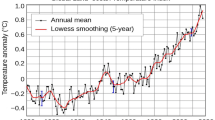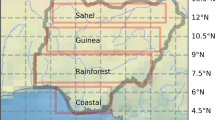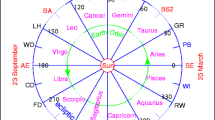Abstract
Current global emphasis is on finding and stimulating clean and renewable energy sources most suitable to given countries or regions. Iran as a country has particularly great potential for using solar energy given the relatively long daily sunshine duration. But understanding sunshine duration (i.e. solar energy potential) requires relevant spatio-temporal knowledge for both the recent past and future decades. We thus present a quantitative perspective on Iran's sunshine duration for the period 1981–2018 (based on station data) and future decades 2041–2080 (based on two modeled scenarios: RCP4.5 and RCP8.5). As might be expected, the findings demonstrate a variety of spatial and temporal changes in sunshine duration for coming decades, in part due to direct or indirect impacts associated with climate change. However, given that physical geographic factors (latitude, longitude, distance from permanent water bodies, elevation) influence sunshine duration across sub-regions of Iran, the effects of these factors are investigated for both the recent-past and future decades. Of these factors, the largest share of influence is latitude (58%), but this will decrease in share of influence to 53% in coming decades. In contrast, although longitude has had a small share of influence in recent decades (7.5%), its share of influence is projected to increase to 13.10% due to climate change by 2061 to 2080.









Similar content being viewed by others
Data availability
Data will be made available on request.
References
Abbaspour KC, Faramarzi M, SeyedGhasemi S, Yang H (2009) Assessing the impact of climate change on water resources in Iran. Water Resour 45:W10434
Ahmadi H, Ahmadi F (2019) Evaluation of sunshine duration and temporal–spatial distribution based on geostatistical methods in Iran. Int J Environ Sci Technol 16:1589–1602
Aghahosseini A, Bogdanov D, Ghorbani N et al (2018) Analysis of 100% renewable energy for Iran in 2030: integrating solar PV, wind energy and storage. Int J Environ Sci Technol 15:17–36. https://doi.org/10.1007/s13762-017-1373-4.
Akbari M, Nodeh V (2015) Analysis of trends in annual and summer rainfall of Golestan Province. Geogr Plan Space Q J 5:141–150 (in Persian)
Alijani, B. (1995), Climate of Iran. Payam-e-Noor Publication, Payam-e-Noor. Tehran, P221 (in Persian)
Alijani B, Roshani A, Parak F, Heydari R (2013) Trends in extreme daily temperature using climate change indices in Iran. Geogr Environ Hazards 1(2):17–28
Alipour Y, Hedjazizadeh Z, Akbary M, Saligheh M (2018) A Study of the subtropical high pressure 500hPa level changes in the Iran’s atmosphere with emphasis on climate change. J Nat Environ Hazards 18:1–17 (in Persian)
Almorox J, Arnaldo JA, Bailek N, Martí P (2020) Adjustment of the Angstrom-Prescott equation from Campbell-Stokes and Kipp-Zonen sunshine measures at different timescales in Spain. Renew Energy 154:337–350
Anis MS, Jamil B, Ansari MA, Bellos E (2019) Generalized models for estimation of global solar radiation based on sunshine duration and detailed comparison with the existing: a case study for India. Sustain Energy Technolo Asses 31:179–198
Arfaoui N, Bouadila S, Guizani A (2017) A highly efficient solution of off-sunshine solar air heating using two packed beds of latent storage energy. Sol Energy 155:1243–1253
Asadi Zarch MA, Sivakumar B, Malekinezhad H, AshishSharma H (2017) Future aridity under conditions of global climate change. J Hydrol 554:451–469
Ashraf A, Jamil K (2022) Solar-powered irrigation system as a nature-based solution for sustaining agricultural water management in the Upper Indus Basin. Nat Based Solut 2:100026
Afsharzade N, Papzan A, Ashjaee M, Delangizan S, Van Passel S, Azadi H (2016) Renewable energy development in rural areas of Iran. Renewable Sustainable Energy Rev 65:743–755
Bakirci K (2009) Models of solar radiation with hours of bright sunshine: a review. Renew Sustain Energy Rev 13(9):2580–2588
Barat Ghobadian, Gholamhassan Najafi, Hadi Rahimi, T.F. Yusaf, Future of renewable energies in Iran,Renewable and Sustainable Energy Reviews,Volume 13, Issue 3,2009,Pages 689-695.
Bakirci K, Kirtiloglu Y (2022) Effect of climate change to solar energy potential: a case study in the Eastern Anatolia Region of Turkey. Environ Sci Pollut Res Int 29(2):2839–2852
Barber D, Lukovich J, Keogak J, Baryluk S, Fortier L, Henry G (2008) The changing climate of the Arctic. Arctic 61:7–26
Bartoszek K, Matuszko D, Soroka J (2020) Relationships between cloudiness, aerosol optical thickness, and sunshine duration in Poland. Atmos Res 245:105097
Bartoszek K, Matuszko D, Węglarczyk S (2021) Trends in sunshine duration in Poland (1971–2018). Int J Climatol 41(1):73–91
Brázdil R, Flocas A, Sahsamanoglou H (1994) Fluctuation of sunshine duration in central and South-Eastern Europe. Int J Climatol 14(9):1017–1034
Chen S, Xiong L, Ma Q, Kim JS, Chen J, YuXu C (2020) Improving daily spatial precipitation estimates by merging gauge observation with multiple satellite-based precipitation products based on the geographically weighted ridge regression method. J Hydrol 589:125156
Dalir F, Shafiepour M, Ashrafi M (2018) A dynamic quasi comprehensive model for determining the carbon footprint of fossil fuel electricity: a case study of Iran. J Clean Prod 188:362–370
Dumitrescu A, Gueymard AC, Badescu V (2017) Reconstruction of historical aerosol optical depth time series over Romania during summertime. Int J Climatol 37(13):4720–4732
Emadodin I, Reinsch T, Taube F (2020) Drought and Desertification in Iran. Hydrology. https://doi.org/10.3390/hydrology6030066
Motamedi A, Gohari A, Haghighi AT Three-decade assessment of dry and wet spells change across Iran, a fingerprint of climate change. Sci Rep 13, 2888 (2023). https://doi.org/10.1038/s41598-023-30040-0
Fan J, Wu L, Zhang F, Cai H, Zeng W, Wang X, Zou H (2019) Empirical and machine learning models for predicting daily global solar radiation from sunshine duration: a review and case study in China. Renew Sust Energ Rev 100:186–212
Fotheringham AS, Brunsdon C, Charlton M (2002) Geographically weighted regression: the analysis of spatially varying relationships. Wiley, Chichester
Georganos S, Abdi AM, Tenenbaum DE, Kalogirou S (2017) Examining the NDVI-rainfall relationship in the semi-arid Sahel using geographically weighted regression. J Arid Environ 146:64–74
Ghanghermeh A, Roshan G, Orosa JA, Costa ÁM (2019) Analysis and comparison of spatial-temporal entropy variability of Tehran City microclimate based on climate change scenarios. Entropy. https://doi.org/10.3390/e21010013
Ghanghermeh A, Roshan Gh, Halabian A (2022) Projecting spatiotemporal variations of sunshine duration with regards to climate change in Iran as a step towards clean energy. Sustain Energy Technol Assess 53:102630
Hadiani M (2015) Uncertainty of climate change and synoptic parameters and modeling the trends. Environ Resour Res 3:179–190
Hosseini V, Shahbazi H (2016) Urban air pollution in Iran. Iranian Stud 49(6):1029–1046. https://doi.org/10.1080/00210862.2016.1241587
Huang F, Wang Z, Liu J, Shuai C, Li W (2020) Exploring rural energy choice from the perspective of multi-dimensional capabilities: Evidence from photovoltaic anti-poverty areas in rural China. J Clean Prod. https://doi.org/10.1016/j.jclepro.2020.124586
Representative concentration pathways (RCPs). IPCC. Accessed 13 Feb 2019.
Kalbali E, Ziaee S, Najafabadi MM, Zakerinia M (2021) Approaches to adapting to impacts of climate change in northern Iran: the application of a Hydrogy-Economics model. J Clean Prod 280:124067
Kamarianakis Y, Feidas H, Kokolatos G, Chrysoulakis N, Karatzias V (2008) Evaluating remotely sensed rainfall estimates using nonlinear mixed models and geographically weighted regression. Environ Model Softw 23:1438–1447
Kitsara G, Papaioannou G, Papathanasiou A, Retalis A (2012) Dimming/brightening in Athens: trends in sunshine duration, cloud cover and reference evapotranspiration. Water Resour Manag 27(6):1623–1633
Kothe S, Pfeifroth U, Cremer R, Trentmann J, Hollmann R (2017) A satellite-based sunshine duration climate data record for Europe and Africa. Remote Sens 9(5):429
Liu W, Wu W, Thakuriah P, Wang J (2020) The geography of human activity and land use: a big data approach. Cities 97:102523
Lorenzo A (2015) Reassessment and update of long-term trends in downward surface shortwave radiation over Europe (1939–2012). J Geophys Res 120(18):9555–9569
Maghsood FF, Moradi H, Massah Bavani AR, Panahi M, Berndtsson R, Hashemi H (2019) Climate change impact on flood frequency and source area in Northern Iran under CMIP5 scenarios. Water 11:273
Manara V, Beltrano MC, Brunetti M, Maugeri M, Sanchez-Lorenzo A, Simolo C, Sorrenti S (2015) Sunshine duration variability and trends in Italy from homogenized instrumental time series (1936–2013). J Geophys Res 120(9):3622–3641
Massah Bavani A, Poormohammadi S, Dastorani M, Rahimian M (2011) Assessment of potential climate change impacts on drought indicators (Case study: Yazd station, Central Iran). Desert 16:157–166
Meunier F, Reis AH (2015) Comment on “Soon, W., and Legates, D.R., Solar irradiance modulation of Equator-to-Pole (Arctic) temperature gradients: empirical evidence for climate variation on multi-decadal timescales.” J Atmos Sol Terr Phys 125–126:8–9
Mojarad F, Moradi K (2014) A study of anomalies and trends of sunshine hours in Iran. Geogr Dev Iran J 12(34):153–166 (in Persian)
Moss R, Mustafa B, Sander B, Eduardo C, Tim C, Jae E, Ismail E, Seita E, Lin E, Kathy H, Roger J, Mikiko K, Jessica K, Jean Francois L, Martin M, Ben M, Jerry M, Leo M, John M, Nebojsa N, Ramon P, Brian O, Keywan R, Steven R, Paul R, Ron S, Detlef V, John W, Tom W, Jean Y, Monika Z (2008) Towards new scenarios for analysis of emissions, climate change, impacts, and response strategies. Intergov Panel Climate Change, Geneva, p 132
Miri M, Derakhshan Z, Allahabadi A, Ahmadi E, Conti GO, Ferrante M, Aval HE (2016) Mortality and morbidity due to exposure to outdoor air pollution in metropolis, Iran. The AirQ model approach. Environ Res 151:451–457. https://doi.org/10.1007/s00703-023-00959-0
Munira S, Sener IN (2020) A geographically weighted regression model to examine the spatial variation of the socioeconomic and land-use factors associated with Strava bike activity in Austin. Texas J Transp Geogr 88:102865
Muzathik A, Nik W, Ibrahim M, Samo K, Sopian K, Alghoul M (2011) Daily global solar radiation estimate based on sunshine hours. IJMME 6(1):75–80
Overland JE, Wang M, Walsh JE, Stroeve JS (2014) Future arctic climate changes: adaptation and mitigation time scales. Earth’s Future 2:68–74
Park JK, Das A, Park JH (2015) A new approach to estimate the spatial distribution of solar radiation using topographic factor and sunshine duration in South Korea. Energy Convers Manag 101:30–39
Paulescu M, Badescu V, Budea S, Dumitrescu A (2022) Empirical sunshine-based models vs online estimators for solar resources. Renew Sustain Energy Rev 168:112868
Polo J, Gastón M, Vindel J, Pagola I (2015) Spatial variability and clustering of global solar irradiation in Vietnam from sunshine duration measurements. Renew Sustain Energy Rev 42:1326–1334
Poodeh SE, Ghorbani R, Hosseini SA, Salmanmahiny A, Rezaei H, Kamyab H (2019) A multi-criteria evaluation method for sturgeon farming site selection in the southern coasts of the Caspian Sea. Aquac 513:734416
Rahimzadeh F, Pedram M, Kruk MC (2012) An examination of the trends in sunshine hours over Iran. Meteorol Appl 21:309–315
Rigal A, Azaïs J, Ribes A (2019) Estimating daily climatological normals in a changing climate. Clim Dyn 53:275–286
Roshan Gh, Farrokhzad M, Attia S (2017) Defining thermal comfort boundaries for heating and cooling demand estimation in Iran’s urban settlements. Build Environ 121:168–189
Roshan GR, Farrokhzad M, Orosa JA (2019a) climate-architecture modeling to explore the effect of land use change scenario on building bioclimatic design pattern in order to provide human thermal comfort. J Environ Health Sci Eng 17:1131–1151
Roshan GH, Saleh Almomenin H, Hirashima S, Attia S (2019b) Estimate of outdoor thermal comfort zones for different climatic regions of Iran. Urban Clim 27:8–23
Roshan G, Grab S, Najafi M (2020) The role of physical geographic parameters affecting past (1980–2010) and future (2020–2049) thermal stress in Iran. Nat Hazards 102:365–399
Roshan Gh, Moghbel M, Taleghani M (2022) Spatial analysis of bioclimatic patterns over Iranian cities as an important step in sustainable development. Sustain Cities Soc 83:103939
Sanchez-Lorenzo A, Calbo J, Martin-Vide J (2008) Spatial and temporal trends in sunshine duration over Western Europe (1938–2004). Int J Climatol 21(22):6089–6098
Sayadi A, Beydokhti NT, Najarchi M, Najafizadeh MM (2019) Investigation into the effects of climatic change on temperature, rainfall, and runoff of the Doroudzan Catchment, Iran, using the ensemble approach of CMIP3 climate models. Adv Meteorol. https://doi.org/10.1155/2019/6357912
Solaun K, Cerdá E (2019) Climate change impacts on renewable energy generation. A review of quantitative projections. Renew Sustain Energy Rev 116:109415
Solaymani S (2021) A review on energy and renewable energy policies in Iran. Sustainability 13(13):7328. https://doi.org/10.3390/su13137328
Some’e BS, Ezani A, Tabari H (2012) Spatiotemporal trends and change point of precipitation in Iran. Atmos Res 113:1–12
Soulayman S, Daudé N (1995) A correction method for solar radiation measurements made using non-calibrated Eppley-type and Robitzsch-type pyranometers. Appl Energy 52:125–132
Srećković N, Lukač N, Žalik B, Štumberger G (2016) Determining roof surfaces suitable for the installation of PV (photovoltaic) systems, based on LiDAR (Light Detection And Ranging) data, pyranometer measurements, and distribution network configuration. Energy 96:404–414
Suehrcke H, Bowden R, Hollands K (2013) Relationship between sunshine duration and solar radiation. Sol Energy 92:160–171
Tahir Z, Hafeez S, Asim M, Amjad M, Farooq M, Azhar M, Amjad G (2021) Estimation of daily diffuse solar radiation from clearness index, sunshine duration and meteorological parameters for different climatic conditions. Sustain Energy Technol Assess 47:101544
Telahun Y (1987) Estimation of global solar radiation from sunshine duration, geographical and meteorological parameters. Sol Wind Technol 4:127–130
Vaghefi SA, Keykhai M, Jahanbakhshi F, Sheikholeslami J, Ahmadi A, Yang H, Abbaspour K (2019) The future of extreme climate in Iran. Sci Rep 9:1464
Weyant J, Azar C, Kainuma M, Kejun J, Nakicenovic N, Shukla PR, La Rovere E, Yohe G (2009) Report of 2.6 Versus 2.9 Watts/m2 RCPP Evaluation Panel (PDF). Geneva, Switzerland, IPCC Secretariat
Wu W, Tang XP, Yang C, Gue NJ, Liu HB (2013) Spatial estimation of monthly mean daily sunshine hours and solar radiation across mainland China. Renew Energy 57:546–553
Yang H, Zhao N, Hao H, Li Q (2009) Decreasing trend of sunshine hours and related driving forces in North China. Theor Appl Climatol 97(1–2):91–98
Yao X, Zhang C, Wang X, Zhang Z, X, Di, (2018) A new correlation between global solar radiation and the quality of sunshine duration in China. Energ Convers Manage 164:579–587
Yoshimura M, Kubota T (2022) Evaluation of sunlight penetration through riparian forest and its effects on stream biota. Glob Ecol Conserv 34:e02043
Zhang X, Du S, Du S, Liu B (2020) How do land-use patterns influence residential environment quality? A multiscale geographic survey in Beijing. Remote Sens Environ 249:112014
Zhao X, Huang G, Lu C, Zhou X, Li Y (2020) Impacts of climate change on photovoltaic energy potential: A case study of China. Appl Energy 280:115888
Zhu W, Wu B, Yan N, Ma Z, Wang L, Liu W, Xing Q, Xu J (2020) Estimating sunshine duration using hourly total cloud amount data from a geostationary meteorological satellite. Atmosphere 11(1):26
Acknowledgements
The authors’ work was partially supported by the Council of Iran National Science Foundation under Grant No.97021735. The authors would like to thank the Council of Iran National Science Foundation for their support in the project.
Author information
Authors and Affiliations
Corresponding author
Ethics declarations
Conflict of interests
The authors declare that they have no conflict of interest.
Additional information
Responsible Editor: Clemens Simmer, Ph.D.
Publisher's Note
Springer Nature remains neutral with regard to jurisdictional claims in published maps and institutional affiliations.
Rights and permissions
Springer Nature or its licensor (e.g. a society or other partner) holds exclusive rights to this article under a publishing agreement with the author(s) or other rightsholder(s); author self-archiving of the accepted manuscript version of this article is solely governed by the terms of such publishing agreement and applicable law.
About this article
Cite this article
Roshan, G., Ghanghermeh, A. & Grab, S.W. Spatio-temporal changes in sunshine duration over Iran: impact of physical geographic components. Meteorol Atmos Phys 135, 28 (2023). https://doi.org/10.1007/s00703-023-00959-0
Received:
Accepted:
Published:
DOI: https://doi.org/10.1007/s00703-023-00959-0




